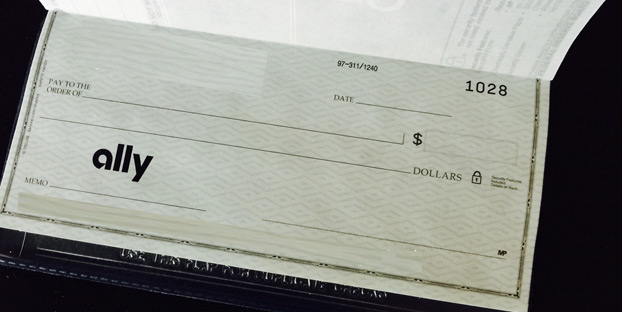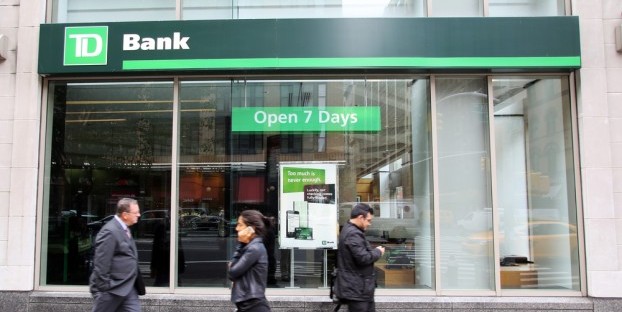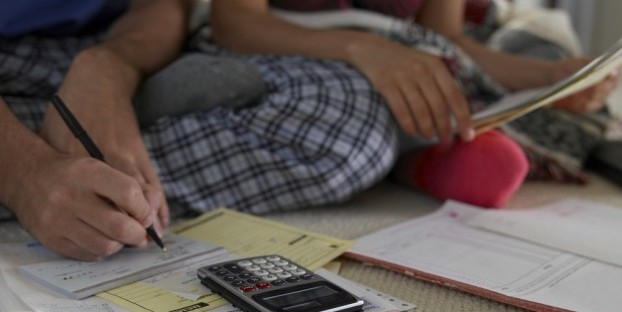Can You Write Two Names on a Check
 Make sure you understand the rules when you have a check written to you and another person.
Make sure you understand the rules when you have a check written to you and another person.
Depositing a check is a seemingly straightforward task when it is written to just one person -- you.
It's a different case when a check is written to multiple payees because many people encounter problems when they try to deposit these checks.
If you are faced with this dilemma, see what hurdles you have to jump through and what you can do to properly deposit your money.
In the rare instance that you ever receive check that is written out to you and another person, it can be a major headache to deposit the check if you don't share an account with this other person.
Today, I clarify the rules for depositing these types of checks, how the top banks handle these check deposits and how you can deal with rejected check deposits.
How is the Check Written to Multiple Payees?
Believe it or not, the way a check is written will have a significant effect on how you deposit a check written to multiple payees. (Don't question it, there are laws under the Uniform Commercial Code that govern the rules for check deposits.)
Let's say that the payees are represented by "John" and "Jane" for these scenarios.
- If a check was written as payable to John "and" Jane, both payees must endorse the check. The rule also applies to payees written to John "&" Jane (note the ampersand symbol)
- If a check was written as payable to John "or" Jane, any one of the payees can endorse the check to have it deposited
- If the wording is ambiguous as to whom the check is written, any one of the payees can deposit the check. Essentially, if it isn't clear, it follows the same rule as if the check is written to John "or" Jane. A common example is when the check is just written as payable to "John Jane."
Hassle to Deposit Checks Written to Two People
Now, when it comes to these checks, you're going to encounter the least amount of problems when they're written in the John "or" Jane form. You can just deposit these checks as if they were written only to you.
For the checks written in John "and" Jane form, it is much more of a troublesome process. You'll have to get the other payees to come with you to a branch to verify their signatures on the back of the check.
Next, I'll show you the policies for the top U.S. banks regarding these types of check deposits.
Get ready for a trip to the branch
I spoke with branch bankers at all of the biggest banks and asked about their policies for depositing a check with multiple people on it.
The rules are generally the same across most of the top U.S. banks with a few additional requirements by some banks.
Basically, when you deposit a check written to multiple payees, all payees must endorse the checks.
Furthermore, all payees must go with you to your bank and present a government-issued ID. This is required to authenticate each payee's signature.
The following banks require you and your payee(s) to present a government-issued ID when at the branch:
- Bank of America (If it is a tax refund check, all payees must also be joint owners of the Bank of America account.)
- Chase
- Wells Fargo
- Citibank
- U.S. Bank
- Capital One
- PNC Bank
- TD Bank (If it is a tax refund check, all payees must also be joint owners of the TD Bank account.)
- BB&T (All payees must also be joint account holders.)
- SunTrust Bank
Banks seem to be more stringent when you're depositing a tax refund check that's written to more than one payee -- Bank of America and TD Bank, for instance, will require that the payees of tax refund checks must also be joint account owners.

Of the big banks, BB&T has the most demanding policy where payees must also be joint accountholders. I think it would pose a major hassle for BB&T customers who come across checks with multiple payees.
"We're worried that anyone can forge a signature, even on a joint account, so all payees will need to come in so that a teller can validate the signature," said the BB&T banker on the phone.
This leads me to the next point of discussion: what to do when you have difficulty with checks that have multiple payees.
When the Bank Won't Accept Your Check
The most problematic situation that I've heard about is when the other payee(s) is unable to visit a branch to verify the check endorsements. It sounds odd, but there are many instances when this can happen.
For example, a woman who filed a restraining order against her ex-husband receives a check payable to both herself and her ex.
Both payees cannot be present at the same branch together, so the bank cannot verify their signatures. A less extreme instance would be if the other payee was out of the country for an extended period of time.

The only alternative would be to contact the payer (the person or entity that wrote the check) and request that another check be written with just one payee's name or have it written in the John "or" Jane format.
If possible, you might even ask the payee to split the amount between two checks so that each payee can deposit the money on their own.
Unfortunately, this will prove to be a laborious chore, especially when it comes to getting government-agency check reissued. But, there is just no way around it.
It'll prove to be even more of a hassle when the bank requires a joint account because there's no other way to deal with this rule besides actually having a joint account.
Be careful: I strongly advise against attempting to deposit a check without having a teller verify the signatures of all payees. Don't try to get tricky and deposit these checks via the ATM because it will get flagged and you could get hit with a returned deposit item fee (which costs an average of $12.85 at the top 10 banks) when the check is ultimately denied.
If you had experience depositing checks with multiple payees, we'd like to hear how you dealt with it in the comments below!
Frustrated with your bank?
Check out these new top banks that people are talking about:
Can You Write Two Names on a Check
Source: https://www.mybanktracker.com/news/top-10-us-banks-rules-check-deposits-multiple-payees
0 Response to "Can You Write Two Names on a Check"
Post a Comment